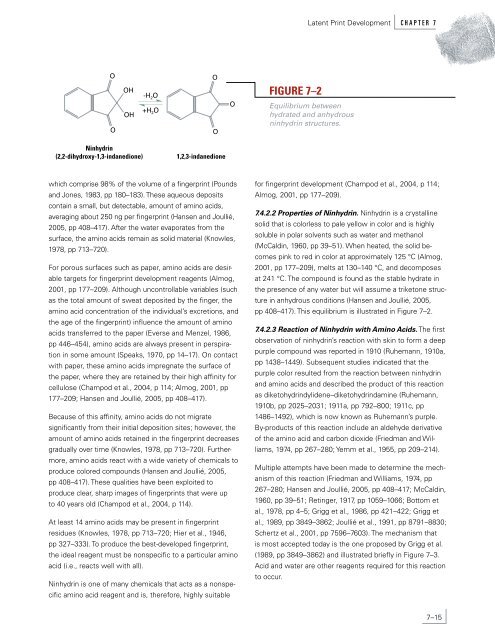Latent Print Development - National Criminal Justice Reference ...
Latent Print Development - National Criminal Justice Reference ...
Latent Print Development - National Criminal Justice Reference ...
Create successful ePaper yourself
Turn your PDF publications into a flip-book with our unique Google optimized e-Paper software.
O<br />
O<br />
OH<br />
OH<br />
-H 2O<br />
+H 2O<br />
Ninhydrin<br />
(2,2-dihydroxy-1,3-indanedione) 1,2,3-indanedione<br />
which comprise 98% of the volume of a fingerprint (Pounds<br />
and Jones, 1983, pp 180–183). These aqueous deposits<br />
contain a small, but detectable, amount of amino acids,<br />
averaging about 250 ng per fingerprint (Hansen and Joullié,<br />
2005, pp 408–417). After the water evaporates from the<br />
surface, the amino acids remain as solid material (Knowles,<br />
1978, pp 713–720).<br />
For porous surfaces such as paper, amino acids are desirable<br />
targets for fingerprint development reagents (Almog,<br />
2001, pp 177–209). Although uncontrollable variables (such<br />
as the total amount of sweat deposited by the finger, the<br />
amino acid concentration of the individual’s excretions, and<br />
the age of the fingerprint) influence the amount of amino<br />
acids transferred to the paper (Everse and Menzel, 1986,<br />
pp 446–454), amino acids are always present in perspiration<br />
in some amount (Speaks, 1970, pp 14–17). On contact<br />
with paper, these amino acids impregnate the surface of<br />
the paper, where they are retained by their high affinity for<br />
cellulose (Champod et al., 2004, p 114; Almog, 2001, pp<br />
177–209; Hansen and Joullié, 2005, pp 408–417).<br />
Because of this affinity, amino acids do not migrate<br />
significantly from their initial deposition sites; however, the<br />
amount of amino acids retained in the fingerprint decreases<br />
gradually over time (Knowles, 1978, pp 713–720). Furthermore,<br />
amino acids react with a wide variety of chemicals to<br />
produce colored compounds (Hansen and Joullié, 2005,<br />
pp 408–417). These qualities have been exploited to<br />
produce clear, sharp images of fingerprints that were up<br />
to 40 years old (Champod et al., 2004, p 114).<br />
At least 14 amino acids may be present in fingerprint<br />
residues (Knowles, 1978, pp 713–720; Hier et al., 1946,<br />
pp 327–333). To produce the best-developed fingerprint,<br />
the ideal reagent must be nonspecific to a particular amino<br />
acid (i.e., reacts well with all).<br />
Ninhydrin is one of many chemicals that acts as a nonspecific<br />
amino acid reagent and is, therefore, highly suitable<br />
O<br />
O<br />
O<br />
FIGURE 7–2<br />
<strong>Latent</strong> <strong>Print</strong> <strong>Development</strong> C H A P T E R 7<br />
Equilibrium between<br />
hydrated and anhydrous<br />
ninhydrin structures.<br />
for fingerprint development (Champod et al., 2004, p 114;<br />
Almog, 2001, pp 177–209).<br />
7.4.2.2 Properties of Ninhydrin. Ninhydrin is a crystalline<br />
solid that is colorless to pale yellow in color and is highly<br />
soluble in polar solvents such as water and methanol<br />
(McCaldin, 1960, pp 39–51). When heated, the solid becomes<br />
pink to red in color at approximately 125 °C (Almog,<br />
2001, pp 177–209), melts at 130–140 °C, and decomposes<br />
at 241 °C. The compound is found as the stable hydrate in<br />
the presence of any water but will assume a triketone structure<br />
in anhydrous conditions (Hansen and Joullié, 2005,<br />
pp 408–417). This equilibrium is illustrated in Figure 7–2.<br />
7.4.2.3 Reaction of Ninhydrin with Amino Acids. The first<br />
observation of ninhydrin’s reaction with skin to form a deep<br />
purple compound was reported in 1910 (Ruhemann, 1910a,<br />
pp 1438–1449). Subsequent studies indicated that the<br />
purple color resulted from the reaction between ninhydrin<br />
and amino acids and described the product of this reaction<br />
as diketohydrindylidene–diketohydrindamine (Ruhemann,<br />
1910b, pp 2025–2031; 1911a, pp 792–800; 1911c, pp<br />
1486–1492), which is now known as Ruhemann’s purple.<br />
By-products of this reaction include an aldehyde derivative<br />
of the amino acid and carbon dioxide (Friedman and Williams,<br />
1974, pp 267–280; Yemm et al., 1955, pp 209–214).<br />
Multiple attempts have been made to determine the mechanism<br />
of this reaction (Friedman and Williams, 1974, pp<br />
267–280; Hansen and Joullié, 2005, pp 408–417; McCaldin,<br />
1960, pp 39–51; Retinger, 1917, pp 1059–1066; Bottom et<br />
al., 1978, pp 4–5; Grigg et al., 1986, pp 421–422; Grigg et<br />
al., 1989, pp 3849–3862; Joullié et al., 1991, pp 8791–8830;<br />
Schertz et al., 2001, pp 7596–7603). The mechanism that<br />
is most accepted today is the one proposed by Grigg et al.<br />
(1989, pp 3849–3862) and illustrated briefly in Figure 7–3.<br />
Acid and water are other reagents required for this reaction<br />
to occur.<br />
7–15

















